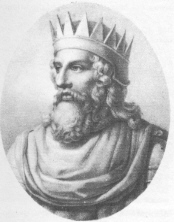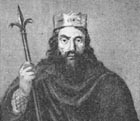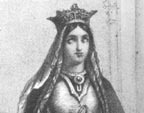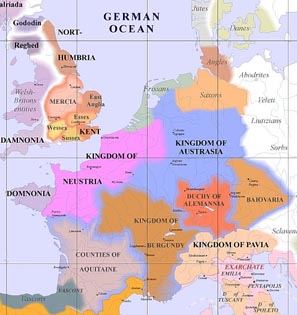The Merovingians
 This page was set up by Robert Sewell in July 2006 to show the descent
of the Counts of Vermandois from Merovech, after whom the Merovingian Kings
of France were named. Robert Sewell graduated from McMaster University
(Hamilton, Ontario, Canada) in 1967 with a B.Sc. degree in chemistry.
After a year of studies at the University of Toronto's College of Education,
he taught high school science in Collingwood, Ontario for a year and then
taught chemistry, physics and general science in Hamilton, Ontario for
twenty-nine years. Robert Sewell retired from teaching in June 1998.
This page was set up by Robert Sewell in July 2006 to show the descent
of the Counts of Vermandois from Merovech, after whom the Merovingian Kings
of France were named. Robert Sewell graduated from McMaster University
(Hamilton, Ontario, Canada) in 1967 with a B.Sc. degree in chemistry.
After a year of studies at the University of Toronto's College of Education,
he taught high school science in Collingwood, Ontario for a year and then
taught chemistry, physics and general science in Hamilton, Ontario for
twenty-nine years. Robert Sewell retired from teaching in June 1998.
Click
to contact Robert Sewell
Please visit the Sewell
Genealogy Site Map for other pages in this series.
The information presented here has
been taken from the following sources:
World Book Millenium 2000 Deluxe Edition,
© 1999 World Book Inc., © IBM Corp.
Microsoft Encarta Encyclopædia 99,
© 1993-1998 Microsoft Corporation
Norman F. Cantor (ed.) The Encyclopædia of
the Middle Ages, New York, 1999
Fredrick L. Weis and Walter L. Sheppard: Ancestral
Roots, Baltimore, 1999
Barnes and Judson: History Atlas of Europe,
Macmillan Inc., New York, 1998
Berhard Grun, The Timetables of History,
New York, 1991
Patrick J. Geary: Before France and Germany,
Oxford University Press, 1988
George Andrews Moriarty: The
Plantagenet Ancestry of King Edward III and Queen Philippa,
Mormon Pioneer Genealogical
Society, Salt Lake City, Utah, 1985.
The Pictorial Encyclopædia,
New York, 1954
The Book of History (18 Volumes), London,
1914
Periodical Historical Atlas
of Europe, http://www.euratlas.com
The Kings of France, http://www.beyond.fr/history/kings.html
Generation One
Chlodio, Chieftain of the Salian Franks
Often described as "King of the Franks",
Chlodio may be more accurately referred to as a "Chieftain of the Salian
Franks". Frankish warriors served as Roman soldiers; and this service was
rewarded as the Salians were allowed to spread out from their "reservation"
known as Toxandria (Tiesterbant near Campine in the southern Netherlands)
into what is to-day Begium, northern France as well as along the lower
Rhine. Much of this expansion was peaceful, although in 428 and again in
450 the Roman general Ætius crushed Frankish uprisings led by Chodio.
At other times, there was close co-operation as in the Frankish support
given Ætius in his defeat of the Huns near Orléans in 451.
. . . Patrick J. Geary: Before
France and Germany, Oxford University Press, 1988, p. 80
. . . Norman F. Cantor: Encyclopædia
or the Middle Ages, New York, 1999, p. 307
Chlodio's successor, possibly a son, and certainly
a relative, was:
-
Merovich, King of the Franks
Generations Two to Nine from Brian Tompsett's Directory
of Royal Genealogical Data which is no longer available online
and from
Patrick J. Geary: Before France and Germany,
Oxford University Press, 1988, p. 232-233
Please note that it is stated in Fredrick L. Weis and Walter L. Sheppard:
Ancestral
Roots,
Line 240 (Baltimore, 1999) that this genealogical information is "questionable".
|
Generation Two
Merovich, Chieftain of the Salian Franks

Acceded in 447; Died in 458
As for Chlodio before him, Merovich
is often described as "King of the Franks". He is also known as Merovech,
Merovæus, Merovée, and Merowig. The Merovingian kings were
named after Merovich.
Merovich is said to have been born
of two fathers. When already pregnant by King Chlodio, his mother went
swimming in the ocean where she was seduced by an unknown marine creature,
a “bestæ Neptuni Quinotauri similis”. This creature, part man,
part bull, and part marine creature, impregnated the Queen a second time.
Thus Merovech carried the blood of the Frankish rulers as well as that
of an aquatic creature.
Merovich and his descendants are known
as "the Sorcerer Kings"; and are said to have possessed supernatural powers
including the abilities to cure illness simply by touching the afflicted
and to tame wild animals as well as clairvoyant and telepathic powers.
Merovich was succeeded by a relative, possibly a son:
-
Childeric I, King of the Franks
Generation Three
Childeric I, Chieftain of the Salian Franks
Acceded: circa 460; Died: 482
Also referred to as "King of the Franks", Childeric
was one of several tribal leaders of the kindred of Chlodio and Merovech.
He began to lead the Franks prior to 463 and was the last Frankish chieftain
to continue the tradition of service under Roman commanders. Although
he had some sort of falling out with the Roman commanders in Northern Gaul,
he remained intimately involved in the world of late Roman civilization.
He may have received direct subsidies from Constantinople as well.
. . . Patrick J. Geary: Before
France and Germany, Oxford University Press, 1988, p. 80
Childeric married to Basina, and they had the following
children:
-
Clovis I, King of the Franks
-
Audefleda
-
Alboflede
-
Lantechilde
Generation Four
Clovis I, King of the Franks
Born in 463?; Acceded in 482; Baptized on September 22,
496; Died in 511.
Clovis is also referred to as Chlodowech,
Chlodovech, Chlodovic, Chlodovicus, and Chlodwig; but "Clovis" is used
most frequently.
Clovis is considered the founder of
the French State. In 486, in co-operation with other Frankish chieftains,
he defeated the last great Roman army in Gaul under the commander Syagrius
near Soissons. He then went on to defeat many minor princes, kings and
tribal chieftains to form the first Frankish Kingdom. However, the
exact chronology of Clovis' reign is hopelessly obscure; even the identity
of the various peoples he is said to have defeated and absorbed into his
kingdom is debatable.
Clovis I married in 493 to Clotilda
(475 - 545), later St. Clotilda, daughter of Childperic, King of the Burgundians.
Clotilda was a Christian and is said to have been instrumental in the conversion
of Clovis I to Christianity. According to legend, an angel gave Clovis
I an iris flower or "fleur-de-lis" after accepting the Christian faith,
and Clovis I then used fleur-de-lis as his symbol.
However, it is entirely unlikely that
Clovis underwent an experience of profound enlightenment during which he
renounced the many Celtic, Germanic and Roman deities to embrace Jesus
Christ. He more likely viewed Christ as another powerful god; an
ally he could call upon to give him victory in battle.
At the time of his death, his kingdom
covered most of what is now France and the western part of Germany.
According to ancient Frankish law and tradition, the kingdom was split
up among his sons Clodomir, Theodoric I (also Thierri I), Childebert I
and Clothaire I. The situation was far from peaceful as the Merovingian
Kings spent much of the next two centuries squabbling over the various
thrones. Although a temporary union of the Frankish Kingdoms occurred several
times when a single heir survived, the situation was chaotic as various
kings sought to displace one another.

|
left: Clovis I (465 - 511),
King of Franks from 481 to 511
right: St. Clotilda (475 - 545),
married Clovis I in 493
|

|
Clovis married in 493 to Clotilda (475 - 545), and they had
the following sons:
-
Chlodomir, King of Orléans
-
Theuderic I (also Thierri I), King of Austrasia
-
Childebert I, King of Paris
-
Clothaire I, King of Neustria
The Main Divisions of the
Frankish Kingdoms under the Merovingian Kings
 |
Aquitaine: modern S.W.
France south of Loire River.
Austrasia: modern N.E. France and
N.W. Germany; sometimes including Neustria.
Bourgogne or Burgundy:
modern S.E. France.
Neustria: modern Belgium and N.W.
France north of Loire River.
courtesy of
http://www.euratlas.com
|
Generation Five
Clothaire I, King of Neustria and Austrasia
Died in 561
Clothaire had the following sons: |
 |
-
Charibert I, King of Austrasia
-
Sigebert I, King of Austrasia
-
Chilperic I, King of Neustria
-
Guntramm, King of Burgundy
Generation Six
Chilperic I, King of Neustria
Died in 584
Chilperic married to Fredegund and they had a son: |
 |
-
Clothaire II, King of the Franks
Generation Seven
Clothaire II, King of the Franks
The Frankish Kingsoms of Neustria, Austrasia and Burgundy
were united briefly under Clothaire II from 623 and 629.
Died in 629
Clothaire had the following sons: |
 |
-
Merovech who is sometimes shown as a brother of Chothaire
II
-
Dagobert I, King of the Franks
-
Charibert II, King of Aquitane
Generation Eight
Dagobert I, King of the Franks
The Frankish Kingsoms of Neustria, Austrasia and Burgundy
were united briefly under Dagobert I from 629 until his death in 639. According
to ancient Frankish law and tradition, the kingdom was split up among his
sons.
Dagobert I was the last great Merovingian ruler. After
his death, powerful officials and aristocratic families played an ever
increasing role in ruling the various kingdoms of the Franks.
Died in 639 |
 |
Dagobert married first to Gomatrud.
Dagobert married second to Nantechild, and they had a
son:
-
Chlodovech (Clovis) II, King of Neustria and Burgundy who
married Baldechildis (St. Balthilidis) and had children:
-
Chlothar III, King of Neustria and Burgundy
-
Childeric II, King of Austrasia who married his cousin Bilichild
-
Theuderic (Thierry) III, King of the Franks who married and had
children:
-
Clovis IV, King of the Franks
-
Childebert III, King of the Franks
-
Chlothare IV, King of Austrasia
-
Bertha (Bertrada), a Merovingian Princess who was perhaps a daughter
of Theuderic (Thierry) III and whose grand daughter was Bertha (Bertrada)
II, wife of Pepin the Short and mother of Charlemagne the Great, Emperor
of the West. (George Andrews Moriarty: The
Plantagenet Ancestry of King Edward III and Queen Philippa, Mormon
Pioneer Genealogical Society, Salt Lake City, Utah, 1985, page 232; Click
HERE
to see this page.) Please click on Pepin
the Short for this line.
Dagobert married third to Ragnetrud, and they had a son:
-
St. Sigebert III, King of Austrasia
Generation Nine
St. Sigebert III, King of Austrasia.
Acceded in 639; Died in 656
Sigebert had the following children:
-
Dagobert II, King of the Franks
-
Bilichild who married her cousin Childeric
II
St. Sigebert adopted the following child:
-
Childebert, King of Austrasia who was a son of Grimoald
and a grandson of Pépin the Old of Landen who was Mayor of the Palace
of Austrasia in 623 and a counsellor of Dagobert (I), King of Austrasia.
Generations Ten to Sixteen are considered "reliable" and are from
Fredrick L. Weis and Walter L. Sheppard: Ancestral
Roots, Line 240 (Baltimore, 1999)
It is stated in Ancestral Roots that the
genealogical information up to this point is "questionable".
|
Generation Ten
Dagobert II, King of the Franks
While Dagobert II was "King of the Franks", palace officials
were by this time playing an ever increasing role in ruling the kingdom.
Following Dagobert's death in 679 or 680, a confusing series of ever weaker
kings, beginning with Dagobert's cousin Theuderic
(Thierry) III, sat on the throne.
Acceded in 676; Died in 679 or 680.
Dagobert had a daughter:
Generation Eleven
Adela
Adela is accepted by Eckhardt as daughter
of Dagobert II but believed by Hlawitscha to be daughter of Hugobert and
Irma, mother of Aubri I, Count of Blois. (The identification of Adela’s
parents depends on a forged charter.)
Adela had a son:
Generation Twelve
Aubri I, Count of Blois
Aubri I had a son:
Generation Thirteen
Aubri II, Count of Blois
Aubri II had a daughter:
Generation Fourteen
Theidlindis
Thiedlindis married Count Gainfroi who flourished circa
795 and was a son of Mainier, Count of Sens, Duke of Austrasia (791 - 796,
died in 800), and his wife, a daughter of Duke Haudre.
-
Thiedlindis and Count Gainfroi had a son:
-
Giselbert, Count in the Massgau
Generation Fifteen
Giselbert, Count in the Massgau
Massgau is in the valley of the Meuse river.
Acceded in 839; Died in 842
Giselbert probably married a sister of Echard, Count of
Hesbaye, and they had a son:
-
Giselbert, Count of Darnau
Generation Sixteen
Giselbert, Count of Darnau
Acceded in 846; Died in 863
Giselbert married Helletrude of Lorraine (also called
Ermengarde), a daughter of the Holy Roman Emperor Lothaire
I and they had a son:
-
Regnier I, Count of Hainaut
Generations Seventeen to Nineteen from
Fredrick L. Weis
and Walter L. Sheppard: Ancestral Roots, Line 140 (Baltimore,
1999) |
Generation Seventeen
Régnier I, Count of Hainaut
Died between October 25, 915 and January 19, 916
Régnier married first to Hersent, a daughter of
Charles
II "The Bald", King of France and they had a son:
-
Régnier II, Count of Hainaut who married Adelaide,
a daughter of Richard of Burgundy.
-
Giselbert, Duke of Lorraine
Régnier married second to Alberade of Mons.
Generation Eighteen
Giselbert, Duke of Lorraine
Died in 939
Giselbert married Gerberga of Saxony, a daughter of Henry
I "the Fowler", King of the Saxons.
Giselbert and Gerberga had a daughter:
Generation Nineteen
Gerberga of Lorraine
Born circa 935
Gerberga married Albert I, Count de Vermandois who is
also known as Adalbert, Count of Vermandois.
Gerberga and Albert had a son:
-
Herbert III, Count de Vermandois
Please click on Herbert
III, Count of Vermandois for the continuation of this line.
Please visit the Sewell
Genealogy Site Map for other pages in this series.
Return to Top
 This page was set up by Robert Sewell in July 2006 to show the descent
of the Counts of Vermandois from Merovech, after whom the Merovingian Kings
of France were named. Robert Sewell graduated from McMaster University
(Hamilton, Ontario, Canada) in 1967 with a B.Sc. degree in chemistry.
After a year of studies at the University of Toronto's College of Education,
he taught high school science in Collingwood, Ontario for a year and then
taught chemistry, physics and general science in Hamilton, Ontario for
twenty-nine years. Robert Sewell retired from teaching in June 1998.
This page was set up by Robert Sewell in July 2006 to show the descent
of the Counts of Vermandois from Merovech, after whom the Merovingian Kings
of France were named. Robert Sewell graduated from McMaster University
(Hamilton, Ontario, Canada) in 1967 with a B.Sc. degree in chemistry.
After a year of studies at the University of Toronto's College of Education,
he taught high school science in Collingwood, Ontario for a year and then
taught chemistry, physics and general science in Hamilton, Ontario for
twenty-nine years. Robert Sewell retired from teaching in June 1998.








